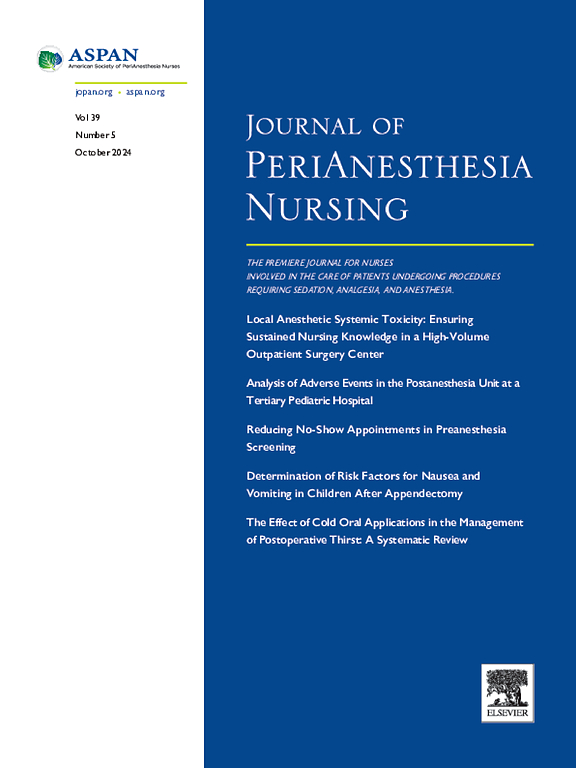Immersive Virtual Reality Versus Video Distraction for the Management of Emergence Delirium in Children: A Randomized Controlled Study
IF 1.6
4区 医学
Q2 NURSING
引用次数: 0
Abstract
Purpose
Emergence delirium (ED) presents challenges for both parents and health care providers in pediatric surgical settings. This study aims to evaluate the effectiveness of immersive virtual reality (VR) distraction and video distraction combined with parental presence in reducing ED in preschool-aged children undergoing elective surgery.
Design
A prospective, randomized, controlled clinical trial was conducted with 90 children ages 4 to 7. Participants were randomly assigned to three groups: VR distraction (group V), tablet video distraction with parental presence (group T), and standard care (group C). The primary endpoints were the incidence of ED and Pediatric Anesthesia Emergence Delirium Scale scores, with secondary measures encompassing scores from the Parental Separation Anxiety Scale and the Faces, Legs, Activity, Cry, Consolability (FLACC) scale.
Methods
Participants were assigned to one of the three intervention groups, and relevant scales were used to assess ED, parental separation anxiety, and postoperative pain. The immersive VR distraction and video distraction with parental presence interventions were compared against standard care.
Findings
Immersive VR distraction significantly reduced the incidence of ED (6.67% in group V vs 40% in group T and 60% in group C), and the incidence of ED in group V was notably lower than in the other groups (P = .023 vs group T and P = .004 vs group C). Children in group V displayed significantly lower FLACC compared with the other groups as well (P < .05). However, no significant differences between the 3 groups were observed in perioperative anxiety as assessed by the Parental Separation Anxiety Scale scores (P = .27).
Conclusions
This study underscores the potential of immersive VR distraction as an effective intervention for mitigating ED in pediatric surgical patients. The findings suggest that incorporating VR technology during the perioperative period can positively impact postoperative outcomes. Further research in diverse surgical contexts is recommended to validate these findings and explore the broader applicability of VR distraction in pediatric health care settings.
沉浸式虚拟现实与视频分散法治疗儿童出现的谵妄:随机对照研究》。
目的:新生儿谵妄(ED)给儿科手术环境中的家长和医护人员都带来了挑战。本研究旨在评估沉浸式虚拟现实(VR)分散注意力的方法和视频分散注意力的方法与家长在场相结合对减少接受择期手术的学龄前儿童谵妄的效果:设计:对 90 名 4 至 7 岁的儿童进行了前瞻性、随机对照临床试验。参与者被随机分配到三组:VR 分散注意力组(V 组)、有父母陪伴的平板电脑视频分散注意力组(T 组)和标准护理组(C 组)。主要终点是ED发生率和小儿麻醉后谵妄量表评分,次要测量包括父母分离焦虑量表和脸、腿、活动、哭泣、安慰(FLACC)量表评分:参与者被分配到三个干预组中的一组,并使用相关量表评估 ED、父母分离焦虑和术后疼痛。将身临其境的 VR 分散注意力干预和有父母陪伴的视频分散注意力干预与标准护理进行比较:身临其境的 VR 分散注意力疗法大大降低了 ED 的发生率(V 组为 6.67%,T 组为 40%,C 组为 60%),而且 V 组的 ED 发生率明显低于其他组别(P = .023,T 组为 0.023,P = .004,C 组为 0.004)。与其他组别相比,V 组儿童的 FLACC 也明显较低(P 结论:V 组儿童的 FLACC 明显低于其他组别):本研究强调了身临其境的虚拟现实分散注意力技术作为一种有效干预措施,在减轻儿科手术患者 ED 方面的潜力。研究结果表明,在围手术期采用 VR 技术会对术后效果产生积极影响。建议在不同的手术环境中开展进一步研究,以验证这些发现,并探索 VR 分散注意力技术在儿科医疗环境中的广泛适用性。
本文章由计算机程序翻译,如有差异,请以英文原文为准。
求助全文
约1分钟内获得全文
求助全文
来源期刊

Journal of Perianesthesia Nursing
NURSING-
CiteScore
2.20
自引率
17.60%
发文量
279
审稿时长
90 days
期刊介绍:
The Journal of PeriAnesthesia Nursing provides original, peer-reviewed research for a primary audience that includes nurses in perianesthesia settings, including ambulatory surgery, preadmission testing, postanesthesia care (Phases I and II), extended observation, and pain management. The Journal provides a forum for sharing professional knowledge and experience relating to management, ethics, legislation, research, and other aspects of perianesthesia nursing.
 求助内容:
求助内容: 应助结果提醒方式:
应助结果提醒方式:


